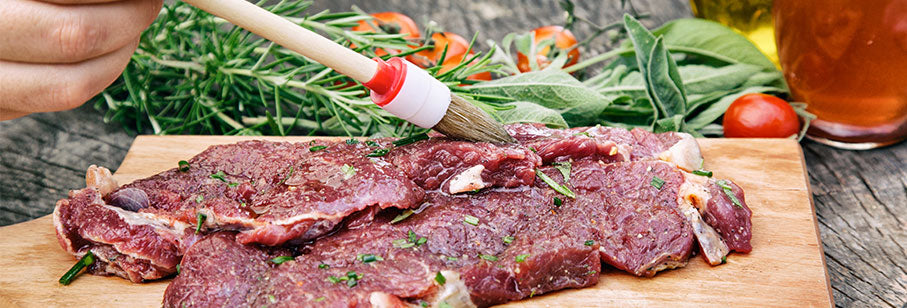By and large, red meat provides superb nutritional value and an array of essential amino acids and nutrients. Unfortunately, red meat has also received some rather unfair or overstated criticism. Looking at you, baby back ribs.
Fact is, though, every kind of red meat offers benefits and perhaps some opportunity for vigilance. Below are the top 5 red meats and what they have to offer. As you will see, there’s no excuse for getting bored in your red meat choices!
1. Beef
When most people think of red meat, beef normally comes to mind. But, there are many different beef products and cuts of beef, ranging from hamburgers to filet mignon. Yet even though there is a large difference in fat between, let’s say, a ribeye and a lean cut of beef, there are some things we can say in general about this very popular meat.
Pros
• Beef provides significant amounts of iron, zinc, and vitamin B12 to your diet. Iron is especially important (particularly this type, called heme iron) for women.
• You will be surprised to learn that the most prevalent fatty acid present in beef – oleic acid – is the same fatty acid that is most prominent in olive oil, well known for its healthful qualities. none other than oleic acid.
• And then there’s creatine, a performance-enhancer which provides energy in explosive movements; beef is loaded with it.
Cons
• Yes, you can get too much of a good thing. Excessive beef consumption can jump your blood iron to unhealthy levels in some folks.
• If you charbroil beef, the actual burning of the meat can form polycyclic aromatic hydrocarbons (PAHs) and heterocyclic amines (HCAs), both of which are carcinogens. This may pose an increased risk of cancer according to animal studies. That said, there are currently no Federal guidelines addressing this issue or stating restrictions on charbroiled beef. In contrast, the American Cancer Institute recommends limiting the intake of red and processed meats (smoked for instance) but offered no recommendations on PAHs or HCAs intake.
What You’re Getting Per 100 grams (about 3.5 oz) of Ground Beef:
• 160 calories
• 22 grams protein
• 8 grams fat (3 saturated)
2. Venison
Venison is a family name for the meat from deer, elk or moose (all members of the deer family). Deer meat is booming in popularity in the US and for good reason. In recent years, sales of venison have been soaring as a result of its perceived healthy reputation among consumers. Venison can be farm raised and sold commercially, or harvested from hunting. Is it a good choice for you? Here’s what you should know.
Pros
• Deer are quite active, which means venison has a lower fat content than other meat.
• Of the fat that is in venison, the ratio of omega 6 to omega 3 fatty acids is about 2:1, which is outstanding.
• Venison is arguably the most nutrient-dense meat available, containing more vitamins and minerals than other meats despite having significantly fewer calories.
Cons
• It is common to pay upwards of $25 to $35 for a pound of venison steak.
• If you are eating hunter harvested deer, assure that the deer was not taken from an area know to have been infected with Chronic Wasting Disease and that the animal was healthy. While the Center for Disease Control has stated that there is no evidence linking Chronic Wasting Disease to human illness, the obvious recommendation is to avoid eating meat from a sick animal.
What You’re Getting Per 100 grams (about 3.5 oz) of Venison:
• 157 calories
• 22 grams protein
• 7 grams fat (3 saturated)
3. Bison
Bison (also referred to as buffalo) is leaner than beef with less saturated fat and cholesterol and has more beneficial fatty acids. Due to its lean quality, it is best when cooked quickly over high heat; for tougher cuts, a low and slow method is best.
Pros
• Bison is lean, great for those wanting to limit total calories but still ingest high-quality protein.
• Bison has a specific flavor that many people find superior to beef.
• The meat itself releases fat more easily during cooking than other meats.
• It is easier to find grass-fed Bison than it is meats from other animals.
Cons
• Price. But, online retailers can ship Bison without breaking your bank account. For instance, one retailer sells one pound of all-natural ground Bison for $55.
What You’re Getting Per 100 grams (about 3.5 oz) of Bison:
• 146 calories
• 22 grams protein
• 6 grams fat (2 saturated)
4. Lamb and Mutton
So, what’s the difference between lamb and mutton? Lamb is from a sheep less than 1-year old, while mutton is the meat of an adult sheep. Similar to beef, there are a variety of lamb cuts.
Pros
• Lamb is high in a great variety of nutrients that are known to be protective and immunity-boosting, such as zinc, selenium and B vitamins.
• Due to the constant grazing of sheep, their meat has an excellent omega 6 to 3 ratio, near 2:1.
• Lamb is also particularly high in iron, thereby helping prevent against anemia.
Cons
• Again, price. Lamb can be expensive.
• Lamb and mutton are a little higher in fat content.
• Source is highly important. Buy only from a meat dealer who sources meat from reputable farms. Sheep can often be housed in dirty environments and sanity butchering conditions is mandatory.
What You’re Getting Per 100 grams (about 3.5 oz) of Lamb or Mutton:
• 282 calories
• 17 grams protein
• 23 grams fat (10 saturated)
5. Wild Boar
Wild boar is just that – a non-domesticated pig that lives in the wild. In general, wild boar has more protein and less fat than regular pork. Although, wild boar is a pig, its meat also contains a good amount of myoglobin so we include it with red meat.
Pros
• A very lean meat with plenty of flavor. Yes, with wild boar you can essentially eat a meat similar to lean pork, but with the flavor of red meat.
• Wild boar is high in monounsaturated fats and zinc.
• This meat is also particularly high in taurine, an antioxidant that can improve heart and muscle function, and glutathione, an antioxidant essential to a variety of functions in the human body.
Cons
• It can be difficult to find good, properly sourced wild boar, but it is out there.
• Be careful. There are more than 24 diseases that people can get from wild hogs, so the meat must be cooked thoroughly. Never undercook wild boar (or any animal in the pork family).
What You’re Getting Per 100 grams (about 3.5 oz) of Wild Boar:
• 160 calories
• 17 grams protein
• 4 grams fat (1 saturated)
Please Let Us Know If You Enjoyed This Article.
Your Feedback Is Important To Us
Disclaimer: This content is for informational purposes only and is not meant as medical advice, nor is it to diagnose or treat any medical condition. Please consult your physician before starting or changing your diet or exercise program. Any use of this information is at the sole discretion and responsibility of the user.













